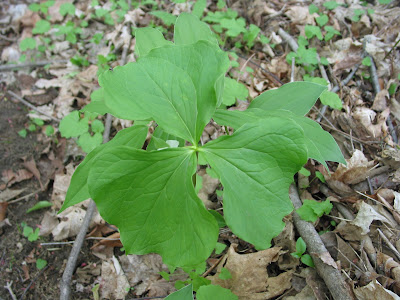Trilliums have caught my eye recently. I spent last weekend in Vermont near Lake Champlain with my sister's family. We climbed the 1,200-foot Snake Mountain in Addison, which provides a fabulous view of the Lake Champlain Valley and the Adirondack Mountains beyond.
The view, looking west, from atop Snake Mountain
The approximately 3.5 mile hike takes 2 to 3 hours and passes through a beautiful hardwood forest of oaks, sugar maple, hickories and hop hornbeam. The forest floor was covered in wildflowers and on the day we hiked white trilliums were in full bloom.
White or large-flowered trillium (Trillium grandiflorum)
The white flowers turn pink as they fade, so it was nearing the end of the flowering season for these trillium. Trilliums are easy to identify as a group, with leaves in a single whorl of three, each with a single three-petaled flower and they grow in cool, rich woods. The large-flowered trillium and its relative the red trillium (or wake-robin) have flowers borne on an erect stalk, or one nearly so, and the leaves have no distinct stalk.
Red trillium (T. erectum)
I am familiar with two other trilliums in our region. The beautifully named and colorful painted trillium, with its white petals and crimson-colored blaze at the base of each petal. The leaves of painted trilliums have short stalks.
Painted trillium (T. undulatum)
The nodding trillium has a flower that dangles below the whorl of leaves. Its petals are recurved. The six stamens have purplish tips (anthers).
Nodding trillium (T. cernuum)
The trilliums are a beautiful group of spring wildflowers. We are fortunate to have them in our region.













No comments:
Post a Comment